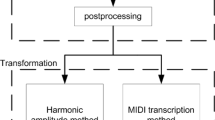Abstract
We present in this paper SingingFunction, a vowel-based sonification strategy for mathematical functions. Within the research field of auditory graphs as representation of scalar functions, we focus in SingingFunction on important aspects of sound design, which allow to better distinguish function shapes as auditory gestalts. SingingFunction features the first vowel-based synthesis for function sonification, and allows for a seamless integration of higher derivatives of the function into a single sound stream. We present further the results of a psycho physical experiment, where we compare the effectiveness of function sonifications based on either mapping only f′(x), or including hierarchically further information about the first derivatives f′(x), or the second derivative f″(x). Further we look at interactivity as an important factor and report interesting effects across all 3 sonification methods by comparing interactive explorations versus simple playback of sonified functions. Finally, we discuss SingingFunction within the context of existing function sonifications, and possible evaluation methods.
Similar content being viewed by others
References
Mansur DL, Blattner MM, Joy KI (1985) Sound graphs: a numerical data analysis method for the blind. J Med Syst 9(3) 163–174
Bonebright TL (2005) A suggested agenda for auditory graph research, pp 398–402, Limerick, Ireland. Department of Computer Science and Information Systems, University of Limerick
Bonebright TL, Nees MA, Connerley TT, McCain GR (2001) Testing the effectiveness of sonified graphs for education: a programmatic research project. In: Proc int conf auditory display. Citeseer, New York, pp 62–66
Stockman T, Nickerson LV, Hind G (2005) Auditory graphs: a summary of current experience and towards a research agenda, pp 420–422, Limerick, Ireland. Department of Computer Science and Information Systems, University of Limerick
Harrar L, Stockman T (2007) Designing auditory graph overviews: an examination of discrete vs continuous sound and the influence of presentation speed, pp 299–305, Montreal, Canada. Schulich School of Music, McGill University
Hetzler SM, Tardiff RM (2006) Two tools for integrating sonification into calculus instruction. In: Proceedings of the twelfth international conference on auditory display (ICAD2006), pp 281–284
Grond F, Droßard T, Hermann T (2010) Sonifunction experiments with a functionbrowser for the blind. In: Proceedings of the 16th international conference on auditory display, pp 15–21. ICAD, Washington
Nees MA, Walker BN (2007) Listener, task, and auditory graph: toward a conceptual model of auditory graph comprehension, pp 266–273, Montreal, Canada. Schulich School of Music, McGill University
Shelton R, Smith S, Hodgson T, Dexter D (2006) MathTrax
Ben-Tal O, Berger J, Cook B, Daniels M, Scavone G (2002) SonART: The sonification application research toolbox. In: Nakatsu R, Kawahara H (eds) Proceedings of the 8th international conference on auditory display (ICAD2002), Kyoto, Japan, 2–5 July 2002. Advanced Telecommunications Research Institute (ATR)
Cassidy RJ, Berger J, Lee K, Maggioni M, Coifman RR (2004) Auditory display of hyperspectral colon tissue images using vocal synthesis models. In: Barrass S, Vickers P (eds) Proceedings of the 10th international conference on auditory display (ICAD2004), Sydney, Australia
Hermann T, Baier G, Stephani U, Ritter H (2006) Vocal sonification of pathologic EEG features. In: Stockman T (ed) Proceedings of the 12th international conference on auditory display, pp 158–163, London, UK, 06 2006. International Community for Auditory Display (ICAD), Department of Computer Science, Queen Mary, University of London, UK
Kleiman-Weiner M, Berger J (2006) The sound of one arm swinging: a model for multidimensional auditory display of physical motion. In: Stockman T, Nickerson LV, Frauenberger C, Edwards ADN, Brock D (eds) Proceedings of the 12th international conference on auditory display (ICAD2006), pp 278–280, London, UK. Department of Computer Science, Queen Mary, University of London, UK
Kramer G (1994) An introduction to auditory display. In: Kramer G (ed) Auditory display. Addison-Wesley, Reading, pp 1–79
McCartney J (2002) Rethinking the computer music language: SuperCollider. Comput Music J 26(4):61–68
Grond F, Bovermann T, Hermann T (2011) A supercollider class for vowel synthesis and its use for sonification. In: Worall D (ed) Proceedings of the 17th international conference on auditory display (ICAD-2011), Budapest, Hungary, June 20–24 2011. OPAKFI
Author information
Authors and Affiliations
Corresponding author
Rights and permissions
About this article
Cite this article
Grond, F., Hermann, T. Singing function. J Multimodal User Interfaces 5, 87–95 (2012). https://doi.org/10.1007/s12193-011-0068-2
Received:
Accepted:
Published:
Issue Date:
DOI: https://doi.org/10.1007/s12193-011-0068-2




